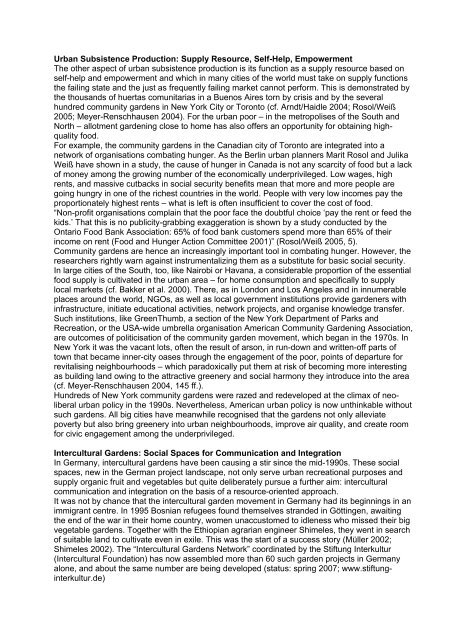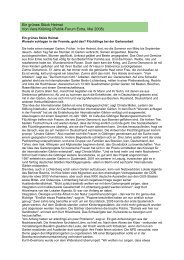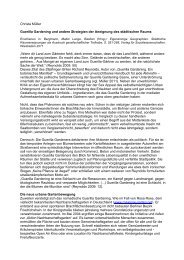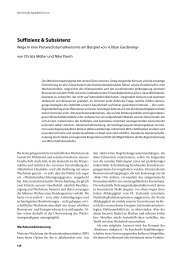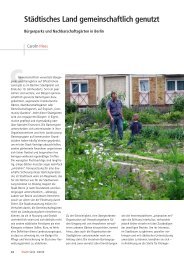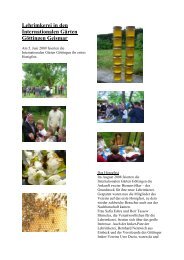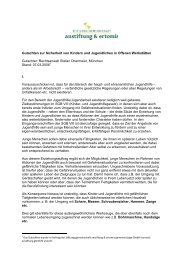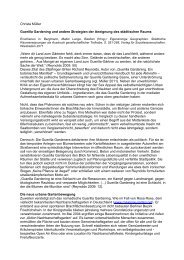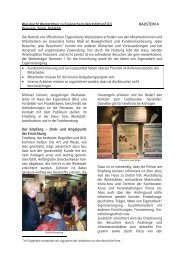Christa Müller - Stiftung Interkultur
Christa Müller - Stiftung Interkultur
Christa Müller - Stiftung Interkultur
You also want an ePaper? Increase the reach of your titles
YUMPU automatically turns print PDFs into web optimized ePapers that Google loves.
Urban Subsistence Production: Supply Resource, Self-Help, Empowerment<br />
The other aspect of urban subsistence production is its function as a supply resource based on<br />
self-help and empowerment and which in many cities of the world must take on supply functions<br />
the failing state and the just as frequently failing market cannot perform. This is demonstrated by<br />
the thousands of huertas comunitarias in a Buenos Aires torn by crisis and by the several<br />
hundred community gardens in New York City or Toronto (cf. Arndt/Haidle 2004; Rosol/Weiß<br />
2005; Meyer-Renschhausen 2004). For the urban poor – in the metropolises of the South and<br />
North – allotment gardening close to home has also offers an opportunity for obtaining highquality<br />
food.<br />
For example, the community gardens in the Canadian city of Toronto are integrated into a<br />
network of organisations combating hunger. As the Berlin urban planners Marit Rosol and Julika<br />
Weiß have shown in a study, the cause of hunger in Canada is not any scarcity of food but a lack<br />
of money among the growing number of the economically underprivileged. Low wages, high<br />
rents, and massive cutbacks in social security benefits mean that more and more people are<br />
going hungry in one of the richest countries in the world. People with very low incomes pay the<br />
proportionately highest rents – what is left is often insufficient to cover the cost of food.<br />
“Non-profit organisations complain that the poor face the doubtful choice ‘pay the rent or feed the<br />
kids.’ That this is no publicity-grabbing exaggeration is shown by a study conducted by the<br />
Ontario Food Bank Association: 65% of food bank customers spend more than 65% of their<br />
income on rent (Food and Hunger Action Committee 2001)” (Rosol/Weiß 2005, 5).<br />
Community gardens are hence an increasingly important tool in combating hunger. However, the<br />
researchers rightly warn against instrumentalizing them as a substitute for basic social security.<br />
In large cities of the South, too, like Nairobi or Havana, a considerable proportion of the essential<br />
food supply is cultivated in the urban area – for home consumption and specifically to supply<br />
local markets (cf. Bakker et al. 2000). There, as in London and Los Angeles and in innumerable<br />
places around the world, NGOs, as well as local government institutions provide gardeners with<br />
infrastructure, initiate educational activities, network projects, and organise knowledge transfer.<br />
Such institutions, like GreenThumb, a section of the New York Department of Parks and<br />
Recreation, or the USA-wide umbrella organisation American Community Gardening Association,<br />
are outcomes of politicisation of the community garden movement, which began in the 1970s. In<br />
New York it was the vacant lots, often the result of arson, in run-down and written-off parts of<br />
town that became inner-city oases through the engagement of the poor, points of departure for<br />
revitalising neighbourhoods – which paradoxically put them at risk of becoming more interesting<br />
as building land owing to the attractive greenery and social harmony they introduce into the area<br />
(cf. Meyer-Renschhausen 2004, 145 ff.).<br />
Hundreds of New York community gardens were razed and redeveloped at the climax of neoliberal<br />
urban policy in the 1990s. Nevertheless, American urban policy is now unthinkable without<br />
such gardens. All big cities have meanwhile recognised that the gardens not only alleviate<br />
poverty but also bring greenery into urban neighbourhoods, improve air quality, and create room<br />
for civic engagement among the underprivileged.<br />
Intercultural Gardens: Social Spaces for Communication and Integration<br />
In Germany, intercultural gardens have been causing a stir since the mid-1990s. These social<br />
spaces, new in the German project landscape, not only serve urban recreational purposes and<br />
supply organic fruit and vegetables but quite deliberately pursue a further aim: intercultural<br />
communication and integration on the basis of a resource-oriented approach.<br />
It was not by chance that the intercultural garden movement in Germany had its beginnings in an<br />
immigrant centre. In 1995 Bosnian refugees found themselves stranded in Göttingen, awaiting<br />
the end of the war in their home country, women unaccustomed to idleness who missed their big<br />
vegetable gardens. Together with the Ethiopian agrarian engineer Shimeles, they went in search<br />
of suitable land to cultivate even in exile. This was the start of a success story (<strong>Müller</strong> 2002;<br />
Shimeles 2002). The “Intercultural Gardens Network” coordinated by the <strong>Stiftung</strong> <strong>Interkultur</strong><br />
(Intercultural Foundation) has now assembled more than 60 such garden projects in Germany<br />
alone, and about the same number are being developed (status: spring 2007; www.stiftunginterkultur.de)


